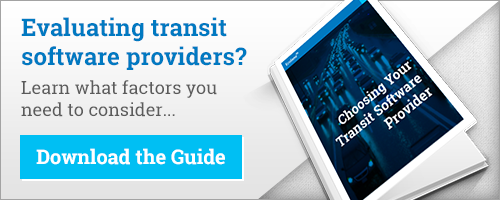Obtaining viable funding opportunities has proved to be an ongoing challenge for the public transportation industry. With the large majority of funding opportunities being attributed to capital grants and government subsidiaries, transit agencies are often faced with tight budgetary constraints. Although this is by no means a new revelation, the increasing popularity of public transportation among today’s consumers has been cause for change within transit agency operations. As ridership continues to grow, transit agencies must adopt the necessary systems, tools, and processes that will allow them to accommodate increasing demands while gaining operational efficiencies and optimizations.
Generating the support, buy-in, and funds needed from key executives and leadership team members to upgrade or adopt new software is much easier said than done. However, the key to building a successful business case is to position the proposed solution in a way that effectively communicates the return on investment (ROI), the short and long-term operational advantages, and the business intelligence that can be realized.
-
Return on Investment (ROI)
‘What does it cost?’ and ‘How long will it take?’ are likely to be the first questions asked by leadership when evaluating a large-scale project such as a transit scheduling software implementation. In today’s competitive climate transit agencies are expected to do more with less, and frankly, resources are limited. Amidst trying to find the right balance between cost and operations, it can be easy for executives to avoid the high price tag associated with the adoption of new technologies. However, helping the leadership team to see past the initial investment in technology and look at the value it can provide will allow them to recognize that the efficiency gains will more than pay for the up-front costs.
-
Operational Advantages
Tolerance for cumbersome systems and inefficient processes is far less than it once was. As more riders begin to utilize public transportation as an alternative to driving, transit agencies will be forced to increase system capacity and reduce operational costs. In the past, agencies looking to reduce operational expenses would have to choose between decreasing service and hiring more staff. However, rather than being burdened with an impossible choice, transit organizations can leverage the data collection, automated vehicle location, and scheduling and dispatching tools of transit scheduling software to create a more efficient, effective, and streamlined operation.
-
Business Intelligence
Having visibility into transit expenses and operations is, and will continue to be, a top priority for leadership teams. Transit scheduling software solutions often come equipped with detailed reporting tools that provide transit agencies with greater insight into their operations. Not only does this allow leadership teams to realize the effectiveness and cost-effectiveness of their operation, but it also facilitates better service planning and more strategic decision making from an ongoing basis. Educating executives on the business intelligence that can be gained, and applied, through new software will help to build a strong business case and make the possibility of adopting new technologies much higher.
Too many transit agencies focus their financial thinking solely around gaining capital funding when in actuality operating funding is equally, if not more, important. While it’s widely understood that there is not a lot of wiggle room when it comes to transit budgets, developing a strong business case around the benefits, efficiencies, and optimizations that can be realized through new or upgraded transit software can persuade leadership into investing the necessary time and resources into creating a more effective transit operation.
About the Author

Ecolane
Read Ecolane's blog articles for perspective, opinion and information on transit and paratransit issues.
%20(200%20x%20100%20px).png)

